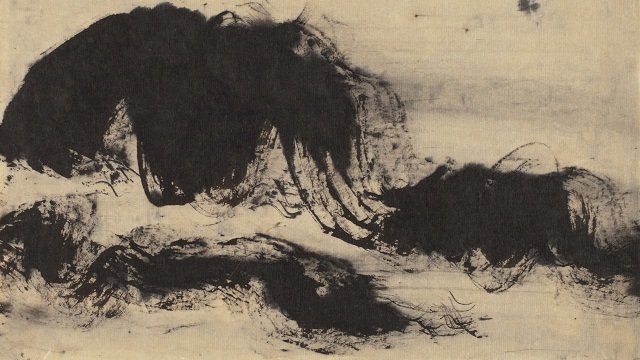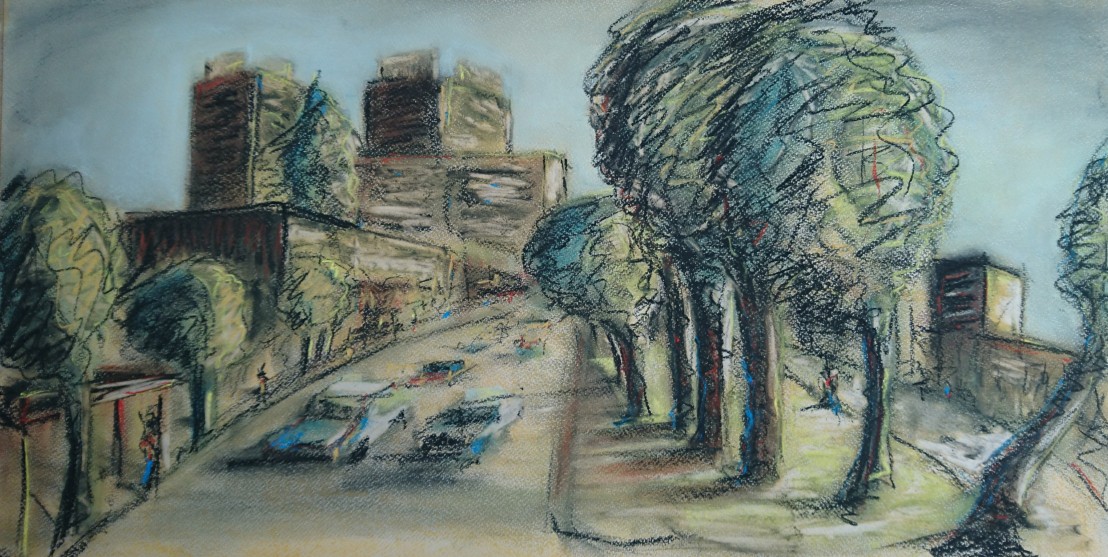Reflection on Part 5
Demonstration of technical and visual skills
I have continued to experiment with different media – in this part I tried different types of graphite and would like to explore this more in future. I also experimented with oil pastel on mylar and started to use gouache for the first time. Finally I settled on using soft pastel and charcoal for my final pieces.
It was apparent from studying the works of Frank Auerbach, David Bomberg, Dennis Creffield, John Virtue and Leon Kossoff that observational skills are key to the success of their work – sketching obsessively over a long period of time – on location, in the street (or rooftop) to use as a final work, or as a study for much larger painting projects. I did not feel comfortable in taking an easel and large board outside in the street – which may have required a second person with me for safety/security – so stuck to making sketches in my A5 sketchbook and a sketchpad – transferring these to larger sheets at home.
My use of the sketchbook has been limited during this course and for Part 5 I have filled a sketchpad with ideas, experiments and location sketches – nearly all related to the Urban Landscape.
My experience of drawing outside particularly with moving traffic and people was interesting and enjoyable – I found myself drawing blind to capture as much as possible:
The above was an experiment in drawing moving traffic – it is interesting how accurate you can become by practice. This is also a good exercise for brain/hand coordination.
In my final pieces which have been influenced by the work of Leon Kossoff, I have included a great deal of information, detail and also movement – movement in line and subjects, such as people or traffic. I believe that this was successful and captured the atmosphere and colour of each chosen site. One of the comments during the coursework was if something did not seem to work – keep drawing – this really helped me, as these final pieces required patience and a building up of layers of colour, of detail and tonal variation.
Kossoff’s work includes many fleeting details – sometimes blindly drawn, often difficult to discover but still there in his drawings and paintings. I have also included these type of details in my work – moving cars and people in the main avenue, people standing at the bus stop in the terminal and people chatting, reading and moving about in the main square.
My compositions were very similar – in a wide-angle triangular format that relied on diagonals and employed the use of foreground, middleground and background details to assist the viewer in moving around the drawing. I was conscious of the viewer as I constructed the drawing to include as much detail and interest as possible without overworking the drawing.
After experimenting with various supports – both smooth and textured and the relationship between line/mark making with these supports, I chose to use a Fabriano paper for the final works with a medium grain to be able to hold more layers of pastel and to allow for a more expressive broken line in both pastel and charcoal. This choice was a good one – this paper being excellent for pastel work. I did try a Strathmore Bristol heavyweight paper with a smoother vellum surface which could also have worked but not exactly what I was looking for on this occasion – When pressing the pastel and charcoal hard on this paper, the mark-making was without grain – with a lighter touch grain is apparent.
Quality of outcome
I was very careful during this final part of the course to heed the advice and guidance giving both by my tutor and the course content in general with respect conceptualisation of thoughts, communication of ideas and application of knowledge gained throughout Drawing 1. This I believe I have achieved and in particular demonstrated in arriving at my Main Avenue drawing – with several sketches, different ideas – relating these ideas and outcomes to my original concept/research of Leon Kossoff’s work – and incorporating improvements and a little of my own voice in the final outcome.
Leon Kossoff’s work encompasses a lifetime’s work in drawing and painting his immediate environment in all weathers and different times of day – this was obvious in his masterly use of line/brushwork in capturing the atmosphere, movement and details of his subject matter. Appreciating this after studying for this part, I will take this forward into my work for POP1.
The most successful drawing in my series of three was the Main Square because of the range of tones, colour, detail and atmosphere captured in the scene.
Demonstration of creativity
During Drawing 1, I have been criticised for overusing line to describe form, where greater tonal contrast would have been more effective. For me therefore using Leon Kossoff was a risk, as he uses heavy line/mark-making in his drawings – particularly in his Arnold Circus drawings.
In taking this risk, I have demonstrated that it is possible to combine a tonal background with expressive line – and that the building up of layers of dark and light colours/tones to describe form coupled with expressive line can work.
I am beginning to have a personal voice in both style and in subject matter – this personal voice has a long way to go yet and I intend to continue with OCA studies to continue improving and building on everything that I have achieved so far.
Context reflection
During the course of Part 5, I visited 4 galleries, 3 in London and 1 in Santiago. In the next few weeks I have an opportunity to visit galleries in Taipei and Shanghai. I have reflected on 4 important exhibitions within the galleries visited and have also watched several important art videos on YouTube – one memorable video was on the work of Tawara Yusaku – a Japanese artist who worked for the latter part of his life exclusively in ink. I hope to see similar ink and watercolour works in Taipei and Shanghai.

My research into artists working in the urban environment was limited to those who either worked/studied together or whose work was influencial upon each other – they have been mentioned before but I believe that David Bomberg was a catalyst for all of them and it was a shame that he was not recognised sufficiently during his lifetime.
My interest in the work of Leon Kossoff (and Frank Auerbach) can be further developed during POP1 – in particular I have an interest in gouache and watercolour – a medium that Kossoff used often, in addition to his work on the human figure and portraiture.
My learning log has improved in that it is starting to be much clearer in demonstrating my thought processes and journey to final pieces.
In POP1 I intend to separate the learning log from the coursework/exercises and have a separate section in the blog for a sketchbook/sketchpad gallery. The idea is to be much clearer in my working processes/experimentation. It is also my intention to change the format of the blog into a fully working website.
Conclusion
In my artist’s statement which I used as the basis for my work on the Urban environment:
Combine line, space and form to create depth, movement and atmosphere in the urban landscape exploring a wide range of media to include graphite, charcoal, pastel, ink, markers, crayons, water-based paints, and collage.
The final work will be a series of up to 5 urban landscapes in a chosen media or use of mixed media.
I believe that I have fully met the brief that I set for myself – I feel limited only by time and want to move forward on to the next module of the OCA Painting course. I feel that I have only scratched the surface of what can be achieved with drawing and drawing techniques.
In my 3 final pieces I created unique spaces with their own lighting, movement and mood. This was created using colour, incorporating detail/interest and incorporating greater depth by the use of tonal contrast and complementary colours.
I chose dry media for these final works but in POP1 I hope to have the opportunity to explore wet media in the Urban Landscape on a variety of supports.
I could have included 5 works for Assignment 5 but limited it to a series of just 3 as these were my strongest pieces.























